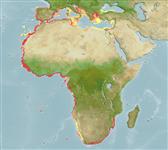Ελασμοβράγχιοι (καρχαρίες και σαλάχια) (sharks and rays) >
Myliobatiformes (Stingrays) >
Myliobatidae (Eagle and manta rays)
Etymology: Aetomylaeus: Greek, aetos = eagle + Greek, mylio = mill, grinder (Ref. 45335).
Environment: milieu / climate zone / depth range / distribution range
Οικολογία
Θαλασσινό(ά); Υφάλμυρο βενθοπελαγικό; εύρος βάθους 10 - 150 m (Ref. 6808). Subtropical; 44°N - 35°S, 19°W - 36°E
Eastern Atlantic: Portugal and Morocco to Angola, including the Mediterranean, Madeira and the Canary Islands; then from Saldanha Bay to Natal (South Africa) and southern Mozambique (Ref. 5578).
Length at first maturity / Μέγεθος / Βάρος / Age
Maturity: Lm 90.0, range 35 - 148 cm
Max length : 222.0 cm WD (female); common length : 150 cm WD αρσενικό/απροσδιόριστο; (Ref. 57025); μεγ. δημοσιευμένο βάρος: 116.0 kg (Ref. 85836)
Short description
Κλείδες προσδιορισμού | Μορφολογία | Μορφομετρία
Long, flat, rounded snout like a duck's bill; head thick and pectoral disc with sharply curved, angular corners; upper or lower jaw; usually with 7 rows of flat teeth (Ref. 5578). Light brown with several pale blue-grey stripes (may be absent) dorsally, white ventrally (Ref. 5578).
Found in coastal tropical and warm temperate waters, occasionally offshore. Sometimes found in small groups (Ref. 5578). Feed on bottom-living crustaceans and mollusks. Ovoviviparous (Ref. 50449), aplacental (Ref. 57025). Prized angling fish, often released (Ref. 5578). Flesh highly esteemed (Ref. 3965).
Exhibit ovoviparity (aplacental viviparity), with embryos feeding initially on yolk, then receiving additional nourishment from the mother by indirect absorption of uterine fluid enriched with mucus, fat or protein through specialised structures (Ref. 50449). Gestation about 6 months; 3-7 young produced (Ref. 5578). Size at birth 45 cm WD (Ref. 6677).
White, W.T., 2014. A revised generic arrangement for the eagle ray family Myliobatidae, with definitions for the valid genera. Zootaxa 3860(2):149-166. (Ref. 97392)
IUCN Red List Status (Ref. 130435: Version 2024-2)
Threat to humans
Harmless
Human uses
αλιεία: Εμπορικό(ά); αλιεία αναψυχής: ναί
Εργαλεία
Special reports
Download XML
Διαδικτυακές πηγές
Estimates based on models
Preferred temperature (Ref.
123201): 13.7 - 24.5, mean 17.2 °C (based on 196 cells).
Phylogenetic diversity index (Ref.
82804): PD
50 = 0.5078 [Uniqueness, from 0.5 = low to 2.0 = high].
Bayesian length-weight: a=0.00389 (0.00119 - 0.01269), b=3.08 (2.83 - 3.33), in cm total length, based on LWR estimates for this (Sub)family-body shape (Ref.
93245).
Τροφικό Επίπεδο (Ref.
69278): 3.8 ±0.57 se; based on food items.
Ελαστικότητα (Ref.
120179): Πολύ χαμηλό, ελάχιστος χρόνος για διπλασιασμό πληθυσμού > 14 έτη (Fec=3).
Fishing Vulnerability (Ref.
59153): Very high vulnerability (83 of 100).
Nutrients (Ref.
124155): Calcium = 6.08 [0.77, 110.95] mg/100g; Iron = 0.496 [0.044, 5.834] mg/100g; Protein = 20.6 [15.3, 25.8] %; Omega3 = 0.146 [0.059, 0.340] g/100g; Selenium = 32.5 [6.1, 179.7] μg/100g; VitaminA = 3.64 [0.33, 39.75] μg/100g; Zinc = 0.455 [0.027, 5.132] mg/100g (wet weight); based on
nutrient studies.
